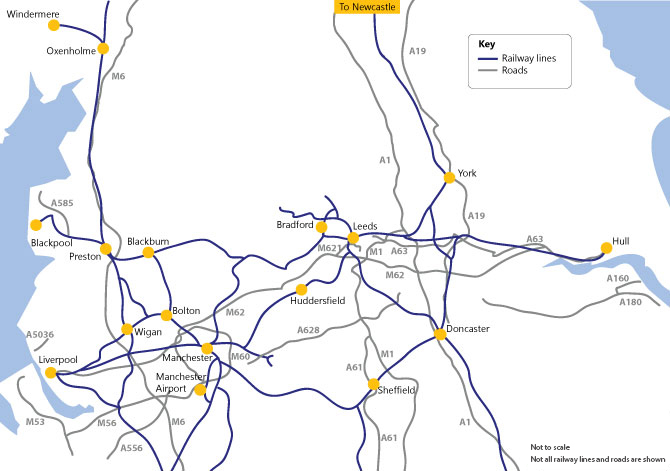Northern Powerhouse transport blueprint
[edit] Overview
On 11 August 2015, the government published a blueprint for £13 billion of government investment in transport to help create the ‘Northern Powerhouse’. (Ref. Gov.uk.)
The government describes the Northern Powerhouse initiative as ‘…a one-nation drive to close the economic gap between north and south by helping the region unleash its full power and create a balanced, healthier economy.’
The government believes that improving transport links in the north will bring its cities and regions closer together making it easier for people and businesses to access markets and deploy their skills.
The transport improvements set out in the blueprint include:
- New electric train services between Manchester, Liverpool and Wigan.
- The opening of the refurbished station at Manchester Victoria.
- A new southern entrance to Leeds station.
- New franchises for modern trains and additional capacity on Transpennine services between Leeds and Manchester and the removal of Pacer trains on Northern routes.
- Faster trains and better services between Sheffield and London.
- Investment in more than 40 major road schemes across Yorkshire, the north east and north west.
- In the longer-term, transforming city to city rail connectivity through HS2 and TransNorth east-west rail links.
Transport Secretary Patrick McLoughlin said that the government was determined to, "…close the economic gap between north and south. Investing in transport – something that successive governments have failed to do sufficiently – is vital to making that happen."
Commercial Secretary at the Treasury Lord O’Neill said, “Investing in first class transport infrastructure is a key part of our commitment to create a Northern Powerhouse. Our investment is helping to better connect the region, building a strong Northern economy, and it is great to see the huge progress already underway.”
Andy Clarke CEO of Asda and member of a new Business Advisory Group created by the Prime Minister said, “Businesses need the right infrastructure and the confidence that government is supporting, not thwarting, their ambitions. Linking our great cities will help to fuel this engine for growth while creating more jobs and opportunities, and the transport schemes being announced today are welcome progress.”
The government also announced that businesswoman Michelle Mone OBE would carry out an independent review of ways to encourage business start-ups and entrepreneurship in disadvantaged communities, including those in the north. This will focus on identifying obstacles faced by people in the most disadvantaged areas and will make recommendations to Work and Pensions Secretary Iain Duncan Smith and Business Secretary Sajid Javid in 2016.
[edit] Updates
In November 2017, new legal powers were announced, giving the North an unprecedented say on how money is spent on transport.
From April 2018, Transport for the North (TfN) will get new powers to:
- Produce a statutory transport strategy for the North which government must formally consider when taking funding decisions.
- Fund organisations to deliver transport projects, e.g. transport operators delivering smart ticketing in the North.
- Work with local authorities to fund, promote and deliver road schemes - and be consulted on rail franchises in the North.
- Take forward smart ticketing to bring in faster, easier rail travel.
[edit] Related articles on Designing Buildings Wiki
- Budget 2015.
- City deals.
- Cities devolution bill.
- Devolution.
- Devolution and development.
- Enterprise zones.
- Going for growth, Reviewing the Effectiveness of Government Growth Initiatives.
- Growth and Infrastructure Bill.
- Growth deal.
- High Speed 2 (HS2).
- Housing growth partnership.
- Housing zones.
- Insights into Northern Powerhouse Rail.
- Local Development Orders.
- Local Enterprise Partnerships.
- Localism Act.
- Northern Powerhouse discussion.
- State of the nation: Devolution.
- Sub-national transport bodies.
- The need for an integrated railway in the Midlands and North.
- What does the Northern Powerhouse mean for us?
Featured articles and news
International Electrician Day, 10 June 2025
Celebrating the role of electrical engineers from André-Marie Amperè, today and for the future.
New guide for clients launched at Houses of Parliament
'There has never been a more important time for clients to step up and ...ask the right questions'
The impact of recycled slate tiles
Innovation across the decades.
EPC changes for existing buildings
Changes and their context as the new RdSAP methodology comes into use from 15 June.
Skills England publishes Sector skills needs assessments
Priority areas relating to the built environment highlighted and described in brief.
BSRIA HVAC Market Watch - May 2025 Edition
Heat Pump Market Outlook: Policy, Performance & Refrigerant Trends for 2025–2028.
Committing to EDI in construction with CIOB
Built Environment professional bodies deepen commitment to EDI with two new signatories: CIAT and CICES.
Government Grenfell progress report at a glance
Line by line recomendation overview, with links to more details.
An engaging and lively review of his professional life.
Sustainable heating for listed buildings
A problem that needs to be approached intelligently.
50th Golden anniversary ECA Edmundson apprentice award
Deadline for entries has been extended to Friday 27 June, so don't miss out!
CIAT at the London Festival of Architecture
Designing for Everyone: Breaking Barriers in Inclusive Architecture.
Mixed reactions to apprenticeship and skills reform 2025
A 'welcome shift' for some and a 'backwards step' for others.
Licensing construction in the UK
As the latest report and proposal to licence builders reaches Parliament.
Building Safety Alliance golden thread guidance
Extensive excel checklist of information with guidance document freely accessible.
Fair Payment Code and other payment initiatives
For fair and late payments, need to work together to add value.
Pre-planning delivery programmes and delay penalties
Proposed for housebuilders in government reform: Speeding Up Build Out.
High street health: converting a building for healthcare uses
The benefits of health centres acting as new anchor sites in the high street.

























